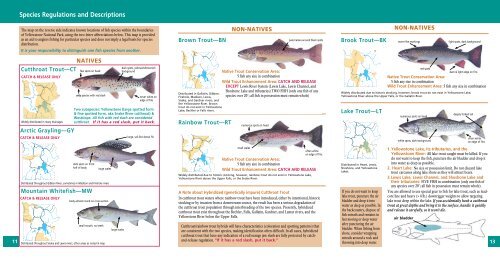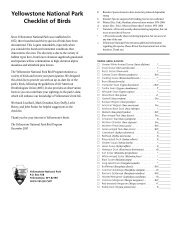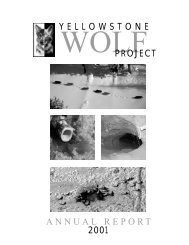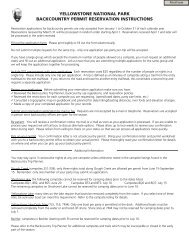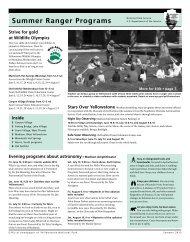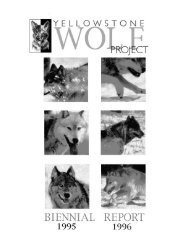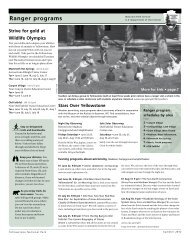Species <strong>Regulations</strong> <strong>and</strong> DescriptionsThe map on the reverse side indicates known locations of fish species within the boundariesof <strong>Yellowstone</strong> National Park, using the two-letter abbreviations below. This map is providedas an aid to anglers fishing for particular species <strong>and</strong> does not imply a legal basis for speciesdistribution.Brown Trout—BNNon-Nativespale haloes around black spotsBrook Trout—BKNon-Nativesworm-like markingslight spots, dark backgroundIt is your responsibility to distinguish one fish species from another.Cutthroat Trout—CTCATCH & RELEASE ONLYWidely distributed in many drainagesArctic Grayling—GYCATCH & RELEASE ONLYNativesfew spots on headonly species with red slashdark spots, yellowish/brownishbackgroundnever white onedge of finsTwo subspecies: <strong>Yellowstone</strong> (large spotted form& fine spotted form, aka Snake River cutthroat) &Westslope. All fish with red slash are consideredcutthroat. If it has a red slash, put it back.large, sail-like dorsal finDistributed in Gallatin, Gibbon,Firehole, Madison, Lewis,Snake, <strong>and</strong> Gardner rivers, <strong>and</strong>the <strong>Yellowstone</strong> River. Browntrout do not exist in <strong>Yellowstone</strong>Lake, Bechler or Falls rivers.Rainbow Trout—RTNative Trout Conservation Area:5 fish any size in combinationWild Trout Enhancement Area: CATCH AND RELEASEEXCEPT Lewis River System (Lewis Lake, Lewis Channel, <strong>and</strong>Shoshone Lake <strong>and</strong> tributaries) TWO FISH (only one fish of anyspecies over 20˝; all fish in possession must remain whole)numerous spots on headred spotsdark & light edge on finsNative Trout Conservation Area:5 fish any size in combinationWild Trout Enhancement Area: 5 fish any size in combinationWidely distributed due to historic stocking, however, brook trout do not exist in <strong>Yellowstone</strong> Lake,<strong>Yellowstone</strong> River above the <strong>Up</strong>per Falls, or the Gallatin River.Lake Trout—LTnumerous spots on headwhite spots, dark backgrounddeeply forked tailoften whiteon edge of fins11dark spots on fronthalf of bodylarge scalesDistributed throughout Gibbon River, sometimes in Madison <strong>and</strong> Firehole riversMountain Whitefish—MWCATCH & RELEASE ONLYbody almost round on cross-sectionsmall mouth, no teethDistributed throughout Snake <strong>and</strong> Lewis rivers, other areas as noted in maplarge scalessmall scalesoften whiteon edge of finsNative Trout Conservation Area:5 fish any size in combinationWild Trout Enhancement Area: CATCH AND RELEASEWidely distributed due to historic stocking, however, rainbow trout do not exist in <strong>Yellowstone</strong> Lake,<strong>Yellowstone</strong> River above the <strong>Up</strong>per Falls, or the Snake River.A Note about Hybridized (genetically impure) Cutthroat TroutIn cutthroat trout waters where rainbow trout have been introduced, either by intentional, historicstocking or by invasion from a downstream source, the result has been a serious degradation ofthe cutthroat trout population through interbreeding of the two species. Presently, hybridizedcutthroat trout exist throughout the Bechler, Falls, Gallatin, Gardner, <strong>and</strong> Lamar rivers, <strong>and</strong> the<strong>Yellowstone</strong> River below the <strong>Up</strong>per Falls.Cutthroat/rainbow trout hybrids will have characteristics (coloration <strong>and</strong> spotting patterns) thatare consistent with the two species, making identification often difficult. In all cases, hybridizedcutthroat trout that have any indication of a red/orange jaw slash are fully protected by catch<strong>and</strong>-releaseregulation. “If it has a red slash, put it back.”Distributed in Heart, Lewis,Shoshone, <strong>and</strong> <strong>Yellowstone</strong>Lakes.If you do not want to keeplake trout, puncture the airbladder <strong>and</strong> drop it intowater as deep as possible. Inthe backcountry, dispose offish entrails <strong>and</strong> remains infast moving or deep waterafter puncturing the airbladder. When fishing fromshore, consider wrappingentrails around a rock <strong>and</strong>throwing into deep water.1. <strong>Yellowstone</strong> Lake, its tributaries, <strong>and</strong> the<strong>Yellowstone</strong> River: All lake trout caught must be killed. If youdo not want to keep the fish, puncture the air bladder <strong>and</strong> drop itinto water as deep as possible.2. Heart Lake: No size or possession limit. Do not discard laketrout carcasses along lake shore as they will attract bears.3. Lewis Lake, Lewis Channel, <strong>and</strong> Shoshone Lake <strong>and</strong>their tributaries: FIVE FISH in combination (only one fish ofany species over 20˝; all fish in possession must remain whole).You are allowed to use special gear to fish for lake trout, such as leadcoreline <strong>and</strong> heavy (> 4 lb.) downrigger weights to allow targetinglake trout deep within the lake. If you accidentally hook a cutthroattrout at great depths <strong>and</strong> bring it to the surface, h<strong>and</strong>le it quickly<strong>and</strong> release it carefully, so it won’t die.air bladder13
Releasing FishVolunteer AnglersAngler Etiquette14u For all native fish <strong>and</strong> any non-native fishyou are intending to release, bring the fishin as quickly as possible. Do not play thefish to exhaustion.u Unhook the fish in quiet water such as aneddy or slow spot. Do not drag the fishacross l<strong>and</strong>. Use a forceps or small needlenosedpliers to quickly remove the hook.u If you must h<strong>and</strong>le the fish, always makesure your h<strong>and</strong>s are wet. (Fish have aprotective mucous film sensitive to dryhuman h<strong>and</strong>s.)u The best way to hold a fish (with weth<strong>and</strong>s) is one h<strong>and</strong> around the tail section<strong>and</strong> the other beneath the belly just behindthe pectoral fins. Never grab or hold a fishthrough the gills unless it is already dead.u If you want a photo of the fish, make surethe photographer is ready before youh<strong>and</strong>le the fish. Make it quick.u Never just throw a fish back into the water.If a fish becomes passive, it is probablyclose to exhaustion. Gently remove thehook within calm water, then lightly cradleTo briefly holda fish beforereleasing it, followthis angler’sexample—hold thefish carefully withwet h<strong>and</strong>s.the fish with your h<strong>and</strong>s to see what itdoes. If it struggles to keep itself upright,hold the fish around its tail <strong>and</strong> beneathits belly with its head facing upstream intothe current. Move the fish gently back <strong>and</strong>forth toward <strong>and</strong> away from the current.You should notice the gills opening <strong>and</strong>closing due to the rush of water. This is likegiving a fish mouth to mouth resuscitation.When the fish has recovered it should swimaway on its own.u Hooks <strong>and</strong> lures typically have barbs whenpurchased. With small pliers you mustpinch down the barbs. Without barbs moreskill is required in l<strong>and</strong>ing <strong>and</strong> bringingin fish but hook removal is easier <strong>and</strong> lesstraumatic to the fish <strong>and</strong> perhaps yourself.u Spinning lures typically have three hookscalled treble hooks. With wire cutters youcan snip off one of the hooks or snap oneoff with pliers; you also must pinch downall the barbs. Two hooks are still effective<strong>and</strong> easier to remove <strong>and</strong> less traumatic.u If the fish is deeply hooked, cut the line—do not pull out the hook. Most fish survivewith hooks left in them.u When filling out the Volunteer AnglerReport (see at right), you can use yourrod to quickly estimate the length of yourfish. Just measure <strong>and</strong> mark (with tape ornail polish) various lengths on your rod.Remember, the less time the fish is h<strong>and</strong>ledout of the water the better chance it has ofrecovering.<strong>Yellowstone</strong> VolunteerFlyfishing ProgramSince 2002, anglers have been directly assisting<strong>Yellowstone</strong>’s fisheries staff. Using catch-<strong>and</strong>releaseangling to capture fish, they gatherbiological information on fish populationslocated throughout the park. Their projectshave included:u determining the range of hybridized<strong>Yellowstone</strong> cutthroat trout in the LamarRiver <strong>and</strong> its major tributariesu documenting the Pebble Creek <strong>and</strong> BeulaLake fisheriesu documenting the status <strong>and</strong> movementpatterns of grayling originating in Grebe <strong>and</strong>Wolf lakes of the Gibbon River systemu documenting the status <strong>and</strong> geneticuniqueness of westslope cutthroat trout inGrayling CreekThrough this program, volunteer anglersexperience many fisheries issues first h<strong>and</strong>, <strong>and</strong>their biological data increases underst<strong>and</strong>ing ofthe park’s fisheries.The Volunteer Angler Report—Your Chance to ContributeSince 1973, anglers have been providingvaluable fishery information to <strong>Yellowstone</strong>National Park managers by filling out theVolunteer Angler Report (VAR) card, which isissued with each fishing permit. Managers usethis information to estimate angling pressure,l<strong>and</strong>ing <strong>and</strong> creel rates, sizes of fish l<strong>and</strong>ed,<strong>and</strong> angler satisfaction. For many park waters,these reports are the only data available. Helpus manage your park’s fisheries by completing<strong>and</strong> returning your VAR card, whether or notyou actually fished or caught fish. To obtaina summary of the data, indicate so in thecomment section <strong>and</strong> include your email orpostal address.u Use established trails <strong>and</strong> avoid sensitivewetl<strong>and</strong> vegetation such as bogs <strong>and</strong> seeps.Heavy trail use in these areas causes erosion<strong>and</strong> loss of habitat essential to many of<strong>Yellowstone</strong>’s wildlife.u Anglers must stay on established trails inthermal areas <strong>and</strong> must not cross theseareas or approach thermal features.u Avoid using the streambed as a pathway.Your footsteps can damage aquatic habitats<strong>and</strong> kill eggs <strong>and</strong>/or fry in the gravel.u Do not overfish a good fishing area. Fish fora while, <strong>and</strong> then move on.u Do not encroach on another angler’s space<strong>and</strong> keep out of sight of other anglers, ifpossible.u During late July <strong>and</strong> August, when watertemperatures can be high, do most of yourfishing early <strong>and</strong> late in the day. Allow fishto rest during the heat of the day.Illegal Actionsu To possess a native cutthroat trout, or anyother native fish.u To bring into the park any live or dead bait(minnows, leeches, salam<strong>and</strong>ers, etc), withone exception. (See page 6, section 4b.)u To transport live fish within the park.u To move water, sediment, fish, fish eggs,aquatic invertebrates, or plants from onewater body to another.u To use parts of trout or any other fish forbait.u To put any substance in the water for thepurpose of attracting fish (chumming).u To leave a fishing line unattended.If you witness a violation, pleasereport it immediately to a law enforcementranger, or call 307-344-7381 <strong>and</strong> press “zero”to immediately reach park dispatch.15


